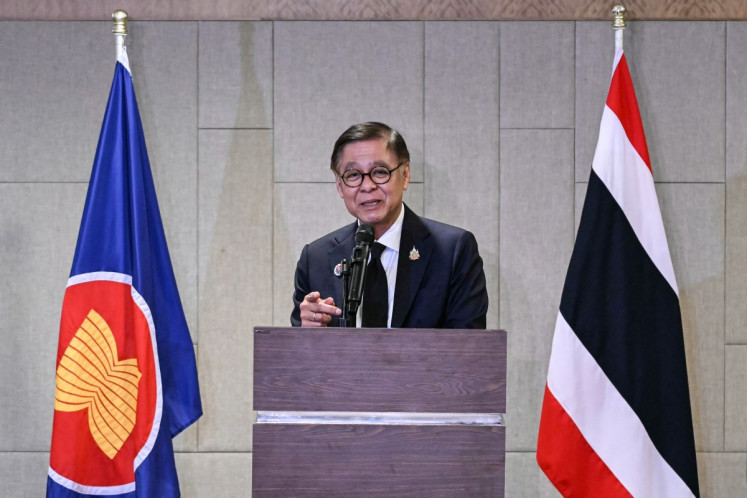Popular Reads
Top Results
Can't find what you're looking for?
View all search resultsPopular Reads
Top Results
Can't find what you're looking for?
View all search resultsState spending in the past decade shows better spending overall
Change text size
Gift Premium Articles
to Anyone
T
he average growth of Indonesia’s state spending in the past decade was recorded at 6.83 percent, rising from Rp 1,777.2 trillion (US$114 billion) in 2014 to Rp 3,621.3 trillion in 2025.
"The key to better spending is not only the amount of spending, but also its reconstruction so that it is more targeted. This provides real benefits to the community along with a strong multiplier effect on the economy," said head of the State Budget Policy Center at the Finance Ministry’s Fiscal Policy Agency (BKF) Wahyu Utomo at a media event in Anyer, Banten on Sept. 25.
Wahyu said the significant growth in spending is expected to provide great benefits to the economy and to all Indonesian people from Sabang to Merauke. The support of large state spending, he continued, also contributes to economic growth and maintains inflation rates.
From 2014 to 2023, the Indonesian economy grew around 5 percent, higher than global economic growth. According to Wahyu, this is a strong basis for economic stability.
Indonesia was able to emerge from the pandemic faster than other countries. After contracting by 2.1 percent in 2020, the Indonesian economy managed to recover to a growth of 3.7 percent in 2021, continuing to strengthen to reach 5.3 percent in 2022.
In addition, the inflation rate was also maintained at a moderate level of 2.5 plus/minus percent, boosting purchasing power.
Wahyu further explained that the state budget has encouraged increased welfare and competitiveness. Education spending for superior human resources from 2015 to 2023 was recorded at Rp 4,006.1 trillion, which among other things succeeded in increasing the number of schools and the gross participation rate of higher education.
From 2014 to 2023, the number of schools at the elementary school level increased from 147,513 to 148,758 schools; at the junior high school level from 36,518 to 42,548; and at the high school level from 24,934 to 28,697 schools. The gross enrollment rate for higher education also increased from 25.76 percent in 2014 to 31.45 percent in 2023.
Furthermore, the health budget was Rp 1,335.5 trillion from 2015 to 2023. The budget has had an impact on significantly reducing the prevalence of stunting from 37.2 percent in 2013 to 21.5 percent in 2023.
The health spending has also succeeded in increasing the number of general hospitals, from only 1,855 in 2014 to 2,636 in 2023. The number of community health centers (puskesmas) has also increased from 9,731 in 2014 to 10,416 in 2023.
Meanwhile, the government has issued a social protection budget of Rp 3,127.6 trillion to improve public welfare from 2015 to 2023. This budget has had an impact on reducing the poverty rate to the single digits, from 11.25 percent in 2014 to 9.03 percent in 2024. This decline was also accompanied by a decrease in inequality (Gini ratio), from 0.406 in 2014 to 0.379 in 2024.
Unemployment has decreased from 5.9 percent in 2014 to 4.82 percent in 2024.
Efforts to increase the productivity of the Indonesian people are also accompanied by increasing connectivity and public facilities to boost competitiveness through infrastructure development, which was allocated Rp 3,167.4 trillion during the 2015 to 2023 period.
The budget has succeeded in increasing the construction of toll roads, from 879 kilometers in 2015 to 2,817 km in 2023.
In addition to adequate performance of government spending, transfers to region (TKD) funds grew significantly from Rp 33.10 trillion in 2000 to Rp 857.60 trillion in 2024.
The distribution of TKD has proven effective in reducing inequality between regions and increasing village independence, with the inter-regional inequality figure decreasing from 0.378 in 2014 to 0.195 in 2023.
In addition, the distribution of village funds has succeeded in increasing the number of independent villages, from 310 villages in 2018 to 17,203 villages in 2024. The number of underdeveloped villages has also decreased, from 27,860 villages in 2018 to 6,100 villages in 2024.
The past decade’s spending also greatly impacted Indonesia’s fiscal performance, with the state budget performance showing an improving trend while state revenues have also increased.
The post-pandemic revenue ratio increased from 10.67 percent of the gross domestic product in 2020 to 13.32 percent in 2023. At the same time, the post-pandemic debt ratio also decreased from 39.37 percent of the GDP in 2020 to 39.21 percent in 2023.
The primary balance in 2023 also recorded prime performance by returning to a positive position after 12 consecutive years in the negative. The deficit is also relatively more controlled, recorded at 1.61 percent of GDP in 2023 compared with an average of 2.2 percent during the pre-pandemic period.
"The deficit is increasingly controlled, meaning the risk is increasingly controlled. The essence of a healthy APBN is that its productivity is higher than its risk. If we can control it and then encourage productivity, this means it is sustainable not only in the short term, but also in the medium and long term," Wahyu concluded.
Source: Finance Ministry











